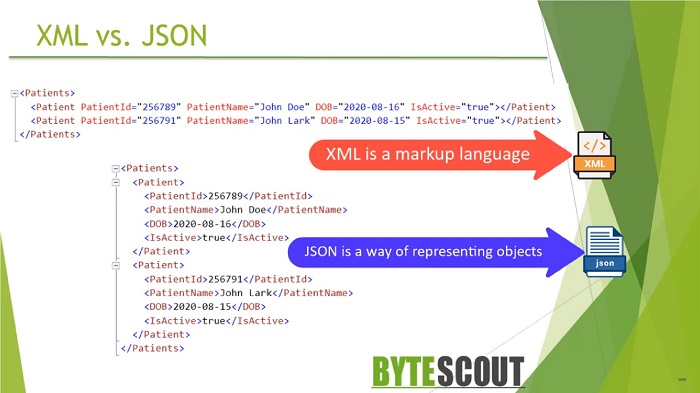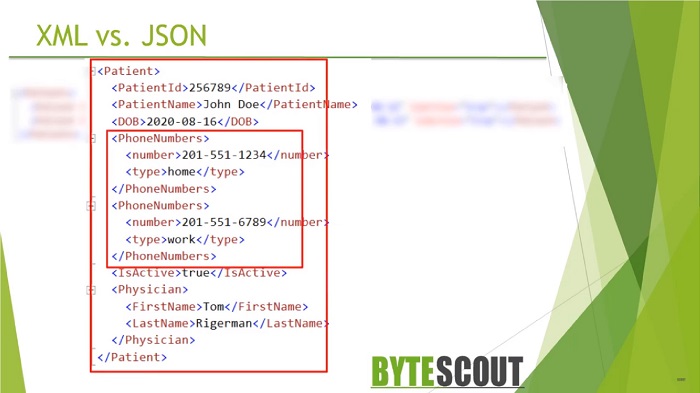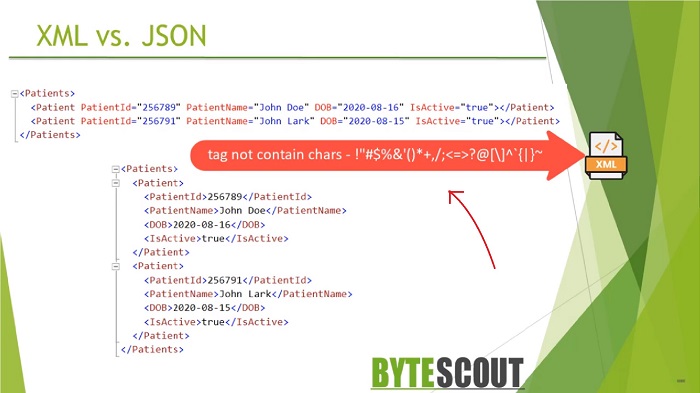JSON vs XML
JSON or XML is used in programming languages because of its simplicity and structured data format. In many ways, you can think of JSON as an alternative to XML at least in terms of Web application and nowadays, for Web API also.
The AJAX concept originally used XML to transmit data between server and browser. But in recent years JSON has become a more popular way to carry AJAX data. JSON and XML have both well-documented open standards on the web and both are human and machine-readable.
Just a few years ago XML was the only choice for open data interchange but developments in open data sharing introduce more options for developers, each with their own set of benefits. As you can see here, XML looks more verbose in comparison with JSON. While JSON has a more complex style than XML, its lightweight approach makes significant improvements in Restful API's while working with complex systems.
Now there is something that many consider a problem with XML and you can represent the same data in multiple different ways. JSON is a lot simpler than XML, as we can see here that there are multiple ways to represent data in XML.
Besides XML’s verbosity, there is one fundamental difference between XML and JSON: XML is a markup language whereas JSON is a way of representing objects. Now let's discuss some of the other disparities between JSON and XML.

JSON looks more like the data structure as we declare in programming languages but most importantly, it has a defined way of distinguishing between a record and a list. Object Notation is practically useless without such distinction, and XML has no such differentiation.
Look at this XML example, here the patient is a record and the phone number is a list but they are not identified as such by the syntax. The advantage of JSON is that the low levels syntax has that distinction built into it. So it's very succinct and Universal.

An example can separate data from metadata via the use of elements and attributes while JSON does not have such a concept. Another key difference is the addressing of values. JSON has objects with a simple key to value mapping whereas in XML addressing happens on Nodes.
The most significant advantage that JSON has over XML is that JSON is a subset of JavaScript. So core to parse and package it fits very naturally into JavaScript code. Another one is XML tag names can not contain any of the characters like this.

It even does not contain a space character whereas JSON keys or names can contain these characters. Simply put, XML is document-oriented while JSON is data-oriented, meaning, JSON can be mapped more easily to object-oriented systems. While XML is widely adopted by the computer industry, JSON's simplicity and the ease of converting from XML to JSON makes JSON ultimately more adoptable.
Building a Restful API, just like our PDF.co cloud API, requires a reliable, fast, and easy-to-use form of data exchange. All of the PDF.co API uses JSON, which we have already seen in previous module sessions. Restful API practices and simpler forms of data exchange have become more popular. JSON will be living XML practices in the test.
PDF.co Web API Document Parser SDK
Video Tutorial:
Other useful articles:
- Essential Secrets of JSON - Introduction to JSON
- JSON Components and Specifications
- Real-World Example of JSON Usage with PDF.co Cloud API
- Why Should I Use JSON Format
- JSON vs XML
- How to Structure JSON – Demo Overview
- How to Beautify JSON
- How to Explore JSON
- Explore JSON Demo using AJAX
- Real-World Example of JSON Usage with PDF.co Cloud API
- Common Mistakes and Gotcha Part 2
- JSON vs CSV vs XML
- Getting Started with JSON Schema
- JavaScript vs JSON
- JSON vs BSON vs GSON
- JSON vs YAML vs TOML